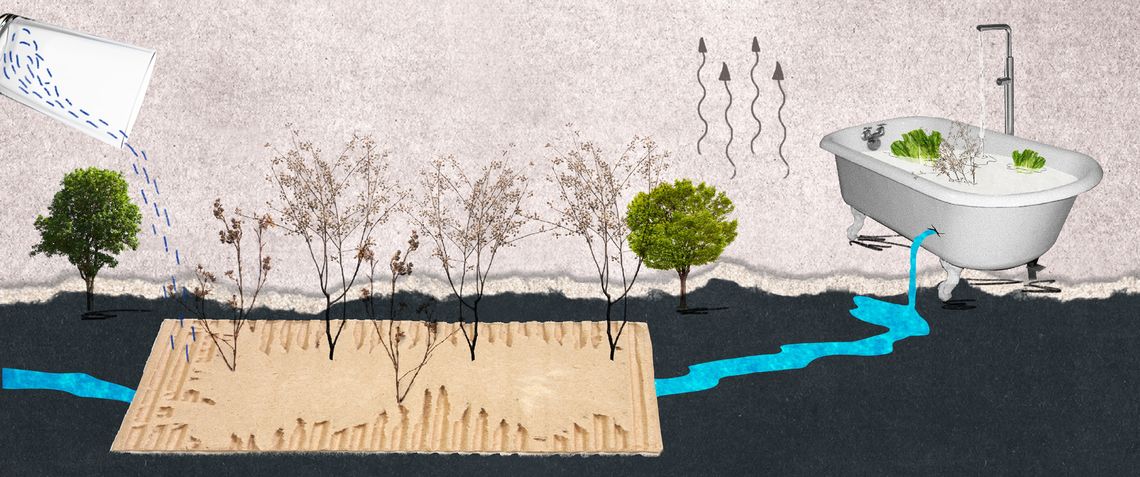
In agriculture, water is life, but the hot summer heat in Armenia makes it a challenge to efficiently bring the country’s water resources to thirsty crops. Drought years make it even harder. Lake Sevan offers a reservoir to draw from during the driest years, but it is a finite resource that then needs time to recover.
Irrigation infrastructure makes up the backbone of Armenia’s agricultural sector, a major component of the overall economy. If it doesn’t operate efficiently, harvest yields drop, and farmer income suffers. Unfortunately, Armenia’s irrigation infrastructure is aging, and it doesn’t always get the water to where it needs to be. In June 2021, residents from more than a dozen communities in the Armavir region blocked the Yerevan-Armavir highway after their irrigation water had been cut for days. The underlying issue was an accident in Malatia, where the lower Hrazdan canal had collapsed.
Aram Sargsyan, the director of the Echmiadzin Water Ratepayers’ Association said that more than half of the canals are 50-60 years old, and similar accidents can be expected to continue to occur. Such incidents leave farmers to fend for themselves in attempting to salvage their harvest. The Ministry of Economy does not keep track of crop damage due to water shortages.
Armenia’s Water Resources
Armenia’s usable water resources come from three main sources: river flow formed in the territory of the Republic of Armenia, Armenia’s share of the flow of transboundary rivers, and renewable groundwater resources. The major transboundary rivers are Araks, Akhurian, Debed, Aghstev, Arpa, Vorotan and Voghji.
Water systems with state significance include more than two dozen reservoirs, the Vorotan-Arpa-Sevan hydro complex with its Arpa-Sevan and Vorotan-Arpa tunnels, the Kechut reservoir and the Elegis hydro station.
There is a shortage of water in the central and northern basins of Armenia. In 2014, the Armenian government declared water shortages in the management areas of the Ararat, Hrazdan and Akhurian basins. In 2020, water scarcity was registered in the management areas of the Northern and Sevan water basins.
The strategic water supplies of the country are defined in the Law on the National Water Program. These are “the quality and quantity of water needed in an emergency (drought, environmental disasters, energy crisis, etc.) to meet basic human needs and to support the preservation of aquatic ecosystems. Strategic water supplies can be increased by accumulating some of the usable water supply in Lake Sevan or in newly-constructed reservoirs.”
At an expert round table held at EcoLur Press Club, Deputy Chairman of the National Water Committee Karen Daghbashyan lays out that “Armenia has an irrigation system of about 17,000 km of water lines and canals, out of which 450 km are main canals, 2,000 km are inter-household water lines, and about 14,000 km are intra-household canals. More than 70% of that 14,000 km system is on land, wherein the lion’s share of our loss falls. We have 250-260 mechanical water production facilities with 700 units. We operate 94 self-drilling wells in the Ararat Valley.”
A number of factors aggravate the challenge of operating an efficient irrigation network.
1) Decreased Water Flows
According to the Chair of the National Water Committee, Karen Sargsyan, river flow has decreased by 40-60% in 2021. The water supply of the Hrazdan River, for example, was about 44 million cubic meters less than in the same period last year.
The Hydrometeorology Monitoring Center presented data showing the percentage decrease in river flow. According to its Deputy Director Levon Azizyan, most rivers saw average monthly outflows decrease by 20-50%. This year, water shortages have been registered in the five large reservoirs monitored by the Center, a decrease of 210 million cubic meters compared to the same time period in 2020 and about 350 million cubic meters less than 2019.
Karen Sargsyan claims that the construction of new small reservoirs will alleviate the problem. Prime Minister Nikol Pashinyan has announced the construction of more than ten new reservoirs.
2) Worn Out Irrigation Systems
According to calculations from different years, 40-50% of irrigation water is lost before reaching its endpoint. The main reason is the poor condition of the water supply systems. They were built in the Soviet era and are falling apart.
The Ministry of Territorial Administration and Infrastructure has been implementing an irrigation system modernization program with a total cost of $50 million since 2019. Most of this sum comes from a loan by the Eurasian Development Bank. The main goal of the project is the construction of gravity flow systems that will replace mechanical irrigation, the reconstruction of the main and inter-farm canals and intra-farm irrigation systems, and the modernization and strengthening of water ratepayers’ associations. After the successful completion of the project, the restored sections of irrigation networks in Armenia will be about 260 km.
3) Fish Farms and Groundwater Resources
According to the Law on the National Water Program adopted in 2006, the renewable groundwater resources of the Ararat Valley amount to 1.1 billion cubic meters/year. However, there is no data on the amount of artesian water used. According to a 2020 Report by the World Bank, the artesian basin of the valley has decreased by about 70%. The Ministry of Environment is in charge of monitoring the situation, for example by enforcing that fish farms adhere to their allotments.
According to the National Water Committee, in the last 15 years, the water intake through boreholes in the Ararat Valley has been about 55 cubic meters per second, which exceeds the permissible average water volume by about 21 cubic meters per second, or 650 million cubic meters per year.
At the end of 2017, the Ministry of Environment registered 239 fish farms in the Ararat Valley, which used 584 deep wells. The actual volume of water used for fish farming was 21,607 L/s, which is about 681.4 million cubic meters per year.
In 2018, the residents of the Ararat Valley told ecolur.org how the use of groundwater has changed their daily life. Water from fish farms is used for irrigation.
Irrigating With Drinking Water
According to a 2004 Government decision, “in settlements (excluding Yerevan) where there are no necessary surface water sources, but there are sufficient resources for drinking water, drinking water can be used for irrigation on a contractual basis in the presence of technical possibilities, financial-economic expediency, appropriate water use permits and lack of irrigation systems. In the case of irrigation of the adjacent plots (gardens) and other plots with drinking water, an additional irrigation fee is calculated for the plot (garden) with irrigation water tariffs operating in the given area (based on the temporary irrigation norms operating in the Republic of Armenia—according to the irrigation regime, the size of the plot, the type of crop being cultivated).”
A previous EVN Report article outlines that, according to the 2014 agricultural census, the average family farm size in Armenia is only 1.48 hectares. Some 2,740 sq. km of land is equipped for irrigation in Armenia, per the Food and Agriculture Organization (FAO) of the United Nations. Data from 2017 suggest that only 1,550 sq. km was irrigated. According to the 2014 agricultural census, almost half (49%) of all farms are irrigated from the main irrigation network. Around 21% use drinking water to irrigate their land, 15% use rivers and lakes, and 12% use wells. In Tavush region, around 60% of all farms are irrigated using drinking water; in Ararat region, 31% use deep wells.
On July 1, 2021, Acting Minister of Economy Vahan Kerobyan, announced that the possibility of drawing 50-70 million cubic meters of water from Lake Sevan to solve this year’s irrigation problems was being discussed.
In the future, the authorities want to promote the introduction of modern irrigation systems. According to Prime Minister Nikol Pashinyan, a new assistance program will be introduced starting in 2022: farms with an area of up to three hectares that have converted to drip irrigation will be exempt from paying water charges for five years.
Programs to support the implementation of modern irrigation systems have also been realized during previous governments, but their coverage throughout the republic is proceeding at a rather slow rate. According to Karen Sargsyan, only 100 out of 130,000 water users have switched to drip irrigation.
Հայերեն
Ինչպես է ոռոգվում Հայաստանը
Water
Magazine Issue N9

In this month’s magazine issue, entitled “Water,” you can find articles on water security, the challenges of irrigation for Armenian farmers, the threat facing Lake Sevan and how water is the source of ancient Armenian traditions.

